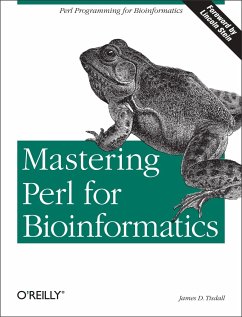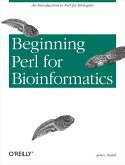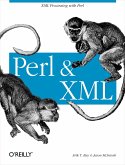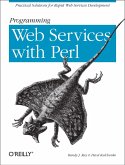Historically, programming hasn't been considered a critical skill for biologists. But now, with access to vast amounts of biological data contained in public databases, programming skills are increasingly in strong demand in biology research and development. Perl, with its highly developed capacities in string handling, text processing, networking, and rapid prototyping, has emerged as the programming language of choice for biological data analysis.
Mastering Perl for Bioinformatics covers the core Perl language and many of its module extensions, presenting them in the context of biological data and problems of pressing interest to the biological community. This book, along with Beginning Perl for Bioinformatics, forms a basic course in Perl programming. This second volume finishes the basic Perl tutorial material (references, complex data structures, object-oriented programming, use of modules--all presented in a biological context) and presents some advanced topics of considerable interest in bioinformatics.
The range of topics covered in Mastering Perl for Bioinformatics prepares the reader for enduring and emerging developments in critical areas of bioinformatics programming such as: * Gene finding
* String alignment
* Methods of data storage and retrieval (SML and databases) * Modeling of networks (graphs and Petri nets)
* Graphics (Tk) * Parallelization
* Interfacing with other programming languages * Statistics (PDL)
* Protein structure determination
* Biological models of computation (DNA Computers)
Biologists and computer scientists who have conquered the basics of Perl and are ready to move even further in their mastery of this versatile language will appreciate the author's well-balanced approach to applying Perl's analytical abilities to the field of bioinformatics. Full of practical examples and real-world biological problem solving, this book is a must for any reader wanting to move beyond beginner level Perl in bioinformatics.
Mastering Perl for Bioinformatics covers the core Perl language and many of its module extensions, presenting them in the context of biological data and problems of pressing interest to the biological community. This book, along with Beginning Perl for Bioinformatics, forms a basic course in Perl programming. This second volume finishes the basic Perl tutorial material (references, complex data structures, object-oriented programming, use of modules--all presented in a biological context) and presents some advanced topics of considerable interest in bioinformatics.
The range of topics covered in Mastering Perl for Bioinformatics prepares the reader for enduring and emerging developments in critical areas of bioinformatics programming such as: * Gene finding
* String alignment
* Methods of data storage and retrieval (SML and databases) * Modeling of networks (graphs and Petri nets)
* Graphics (Tk) * Parallelization
* Interfacing with other programming languages * Statistics (PDL)
* Protein structure determination
* Biological models of computation (DNA Computers)
Biologists and computer scientists who have conquered the basics of Perl and are ready to move even further in their mastery of this versatile language will appreciate the author's well-balanced approach to applying Perl's analytical abilities to the field of bioinformatics. Full of practical examples and real-world biological problem solving, this book is a must for any reader wanting to move beyond beginner level Perl in bioinformatics.
"Die `Einführung in Perl für Bioinformatik´, ebenso wie das vorliegende Buch bei O'Reilly erschienen und von James D. Tisdall verfasst, wurde bereits in der Ausgabe 05.02 vorgestellt. Bemängelt wurde damals das Fehlen einiger erweiterter Themen wie das der objektorientierten Programmierung unter Perl. Mit seinem zweiten Buch `Mastering Perl for Bioinformatics´ setzt der erfahrene Bioinformatiker James D. Tisdall seinen Lehrgang `Perl für Biologen´ fort und widmet sich fortgeschritteneren Themen wie der CGI- oder der Grafikprogrammierung. Den weitaus größten Teil mit ca. 200 Seiten machen jedoch die Kapitel zur OOP aus. Hier wird anhand praktischer Beispiele nicht nur die Verwendung, sondern auch die Implementierung von externen Modulen und Klassen erläutert. Der zweite Teil beschäftigt sich schließlich mit den Grundlagen von relationalen Datenbanken, die Abfragesprache SQL und das Datenbanksystem MySQL inbegriffen, den Grundzügen des Webs einschließlich der CGI-Programmierung und schließlich der Grafikprogrammierung mit der Bibliothek GD. Leider viel zu kurz geraten - und gleichermaßen wenig informativ wegen der ellenlangen Listings ist die Einführung in BioPerl, dem Perl-Modul für Biologen. Die verbleibenden 50 Seiten wurden auf zwei Anhänge verteilt, die erstens einen knappen Überblick über die Funktionalität von Perl vermitteln und zweitens die Installation von Perl auf verschiedenen Plattformen erläutern. Beide Anhänge hätte man jedoch zu Gunsten weiterer Kapitel (z.B. zu XML!!!) streichen können. Die Abhandlung über die Installation ist zu kurz, als dass sie bei ernsthaften Problemen tatsächlich helfen könnte, und die Perl-Zusammenfassung wurde in Teilen aus dem vorherigen Werk übernommen. Schade, denn sieht man einmal von den Anhängen und dem Kapitel zu BioPerl ab, so kann das Buch durchaus als gelungene Einführung in die fortgeschrittene Perl-Programmierung empfohlen werden. Doch zumindest ich persönlich hatte mir mehr `Stoff´ von diesem zweiten Werk erwartet." -- Linux Enterprise, 03/2004, Martin Szugat








